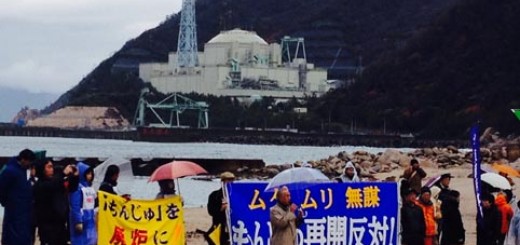Toward Monju Restart Nuke Info Tokyo No. 119
completion of modifications, sodium refill, functional tests
The Japan Atomic Energy Agency (JAEA) has been carrying out modifications on the Monju Prototype Fast Breeder Reactor (FBR, 280 MW) in preparation for restart (see NIT 110). These modifications are almost complete and the secondary cooling pipes have been refilled with sodium. In June JAEA announced that the work was 98% complete.
Monju’s secondary cooling system has three loops. Since the accident in December 1995, an electric motor has been pumping sodium, electrically heated to 200oC, through the pipes of one of these loops. After the sodium leak and fire, sodium was removed from the loop where the accident occurred. A few years later, sodium was removed from another loop and replaced with argon gas.
Before replenishing the sodium, the secondary system thermocouples were replaced. The cause of the Monju accident was a problem in the design of the casing of these thermocouples. They have been changed from a stepped design to a tapered design and shortened from 185.5 mm to between 60 and 110 mm (see illustration in NIT 110). Also the number of thermocouples in the secondary system has been reduced from 48 to 42.
The modifications involved (1) improved measures to address the problem of sodium leaks in the secondary system, and (2) improved detection of sodium leaks in the steam generator. In regard to the first of these, besides redesigning the thermocouple casing, the following changes have been made:
- The diameter of the drainpipes has been increased to improve sodium drainage.
- TV monitoring has been improved.
- To prevent sodium coming in contact with concrete, steel panels have been fitted over the concrete walls.
- A system has been added to fill the secondary pipe rooms with nitrogen in an emergency.
In regard to the steam generator, the number of pressure detectors has been increased from two to three. In order to minimize the damage from sodium-water reactions, it is necessary to quickly detect leaks of water from cracks or pin-holes in the steam generator into the sodium coolant. A sodium-water reaction could cause steam tubes to rupture, resulting in a serious accident. The reason for increasing the number of detectors was that during the court case it was revealed that there had been a cover-up regarding the assessment of the damage that could be caused. As a result, the assessment had to be redone.
Monju has been closed down for 12 years. Power generation equipment was taken apart and stored. While it has been out of operation, circulation of sodium has been maintained in the primary system. The fuel was not removed, so altogether it has been submerged in sodium for over 13 years. As mentioned above, two of the secondary loops have been filled with argon gas. Loop C, in which the leak occurred, will be filled with sodium (228 m3) for the first time in eleven and a half years.
The question is, are these measures adequate? JAEA’s checks have been piecemeal. There are concerns about the fuel cladding, but external checks using cameras have been carried out for only one fuel assembly in the core and one in the blanket out of a total of 370 fuel assemblies (198 core, 178 blanket). Also, we are concerned that there will be no visual checks of the inside of secondary system piping, especially of pipes from which the sodium was removed. It would be expected that in some places sodium would have stuck to the pipes. This could give rise to corrosion, but it will not be checked. In regard to the heat conducting pipes of the steam generator, eddy current tests and visuals checks will be carried out to check for damage to the inside, but there will be no visual checks of the outside of the pipes. This is the part which was in contact with sodium. The leaked sodium vapor from the accident spread through about 70% of the secondary system building. Sodium adhered to electric equipment, such as distribution boards and cables. JAEA wiped this off, but only what could be seen.
Also, earthquake safety checks are being redone, but this only involves boring within the site limits. No investigations are planned offshore. The earthquake at Kashiwazaki-Kariwa showed clearly that this is not sufficient. The anxieties of the local residents will not be allayed by such perfunctory investigations.
The schedule is to start up the reactor in May 2008, after the functional tests. The reactor cannot be started up just with the fuel which is currently loaded. The reason for this is that half of the pulutonium-241 in the reactor has already decayed to americium. Therefore, 78 new replacement fuel assemblies will be loaded. These have already been made.
Hideyuki Ban (CNIC Co-director)

